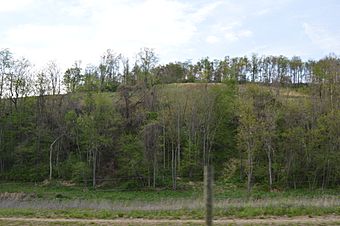Francis Farm Petroglyphs facts for kids
Quick facts for kids |
|
|
Francis Farm Petroglyphs Site (36FA35)
|
|

Overview of the site
|
|
| Location | Off Perry Road in Jefferson Township, Fayette County, Pennsylvania, 1 mile (1.6 km) west of the junction of Pennsylvania Routes 51 and 201 |
|---|---|
| Nearest city | Perryopolis |
| Area | 0.1 acres (0.040 ha) |
| NRHP reference No. | 84003370 |
| Added to NRHP | May 10, 1984 |
The Francis Farm Petroglyphs are ancient rock carvings found in southwestern Pennsylvania. These special carvings, called petroglyphs, are on a large rock in Fayette County. People who study old cultures, called archaeologists, have known about this site since the mid-1800s. Even though it was damaged a bit in the 1930s, it's still a very important place. Because of its historical value, it has been named a historic site.
Contents
Who Made the Francis Farm Petroglyphs?
We know for sure that Native Americans created the Francis Farm petroglyphs. However, it's hard to say exactly which group made them. Archaeologists think they might have been made by people from the Monongahela culture or the ancestors of the Shawnee. Both of these groups lived in southwestern Pennsylvania during the later part of the Woodland period.
Where Are the Francis Farm Petroglyphs Located?
The petroglyph site is on a big rock formation, also called an outcrop, in Jefferson Township. It's about 2.6 miles (4.2 km) west of Perryopolis. The rock is made of sandstone and is shaped like a rectangle. It measures about 6.3 metres (21 ft) from north to south and 5.7 metres (19 ft) from east to west.
The top surface of the rock, where the carvings are, slopes downwards. The western side of the rock rises about 3.2 metres (10 ft) above the ground. The eastern side is level with the ground. Other similar rocks are nearby, but only this one has Native American carvings. The site is surrounded by trees and bushes.
What Do the Francis Farm Petroglyphs Show?
There are carvings on six different rocks at Francis Farm, but only one main rock has Native American petroglyphs. Another rock nearby used to have similar carvings, but it was destroyed in the 1930s. This happened when the land was being quarried to build a road.
The carvings on four other rocks are newer. They include letters and pictures of guns, showing they were made much more recently.
On the main rock, there are at least sixteen different carvings. These carvings can be put into seven groups:
- Things people made (artifacts)
- Geometric shapes
- Parts of the human body
- Mammals (like animals with fur)
- Reptiles (like snakes)
- A shape that looks like the letter "W"
- Small pits or holes
Some carvings have many parts. For example, one design has seven small pits, which are sometimes called "nut-cracker holes." The most common carvings are of the human body. Designs 2 and 10 show a full human shape, while designs 1 and 15 are pictures of human heads.
Other interesting images include what might be a mythological "spirit otter" (design 5), a four-footed animal (design 6), and a rattlesnake (design 11). The "W" shape is also found at other petroglyph sites. It might be an abstract design, but archaeologist James L. Swauger called it a "W" to make it simple. Some carvings, like arrows and hook shapes, are thought to be recent additions by people who damaged the site.
The unusual shapes found among the carvings are common in Native American petroglyphs. We don't know their exact meanings. However, they look like shapes found at similar sites in the upper Ohio River valley. This suggests that many of these sites were made by the same or similar ancient cultures. Other common designs at these sites include shapes and footprints of birds, humans, and other mammals.
Why Are These Petroglyphs Important?
The Francis Farm Petroglyphs have been known for a long time, since at least the mid-1800s. Books written in 1843, 1893, 1930, and 1934 mention the site. In 1958, Carnegie Museum of Natural History archaeologist James Swauger officially recorded the site.
Even with all this attention, the site has stayed in good condition. Natural processes have caused some wear over time. Also, Swauger couldn't find every detail that earlier surveys mentioned. But most of the original designs are still easy to see today.
When Europeans first settled in southwestern Pennsylvania, there were several petroglyph sites in Fayette County. Some of these sites, like the New Geneva Petroglyphs and the Dunn Farm Petroglyphs, survived into modern times. However, many sites in the upper Ohio River valley were destroyed in the late 1900s. This makes the Francis Farm site very valuable for people who want to study Native American rock carvings in the future.
Because of their great archaeological importance, the Francis Farm Petroglyphs were added to the National Register of Historic Places in 1984. This means they are recognized as a significant historical place in the United States.



